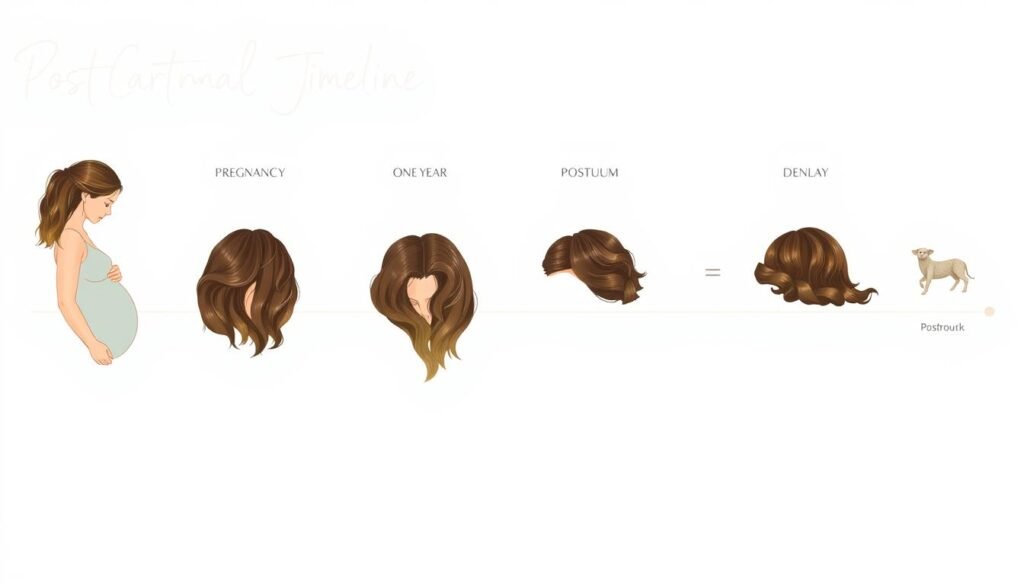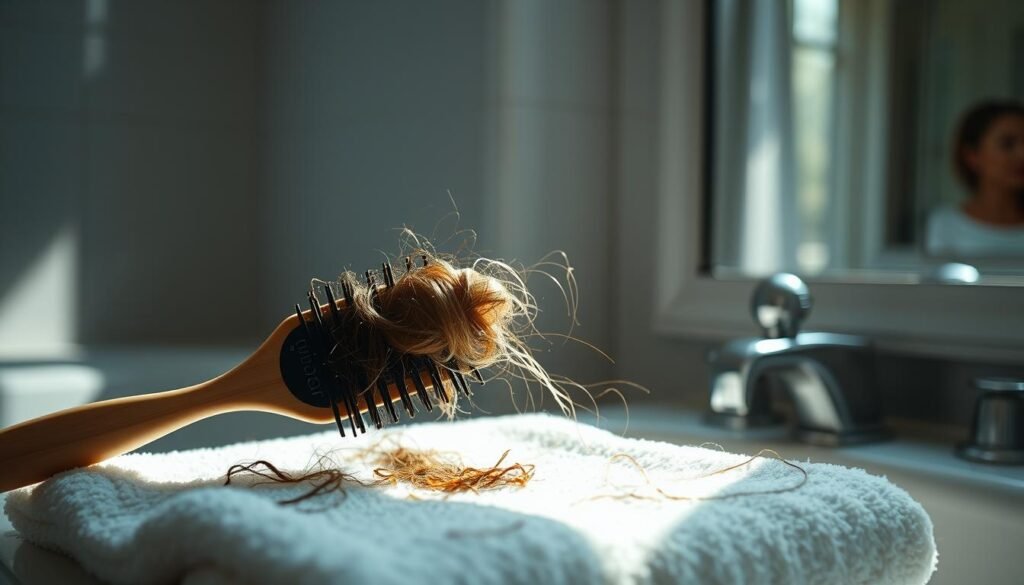Understanding Postpartum Hair Loss: A Guide for New Moms
A staggering 91.8% of new mothers experience postpartum hair loss, a phenomenon that can be both alarming and emotionally taxing. This Guide offers comprehensive insights into the causes, timeline, and management strategies for this Common yet underappreciated challenge faced by many women after childbirth.
Postpartum hair loss, also known as telogen effluvium, is a temporary condition that affects a significant portion of the population. The excessive shedding is a natural consequence of the hormonal fluctuations that occur during and after pregnancy, as the body adjusts to the dramatic shifts in estrogen and progesterone levels.
With a deeper understanding of the underlying causes and the typical timeline of postpartum hair loss, new mothers can navigate this transition with greater confidence and find effective ways to manage the shedding, support hair regrowth, and ultimately, embrace their evolving appearance.
Key Takeaways
- Postpartum hair loss affects up to 91.8% of new mothers, a staggeringly high percentage.
- The excessive shedding is a natural consequence of hormonal fluctuations during and after pregnancy.
- Postpartum hair loss typically starts around 3 months after delivery and can last for 3 to 6 months.
- A healthy, balanced diet and proper nutritional support can help maintain hair strength and promote regrowth.
- With patience and the right Hair Care strategies, most new mothers can expect their hair to return to its usual fullness within a year.
What is Postpartum Hair Loss?
Postpartum hair loss, also known as telogen effluvium, is a Common experience for new mothers. This excessive shedding of hair is caused by the hormonal changes that occur after childbirth. It typically begins around three months postpartum and can last up to a year. Postpartum alopecia is not a true hair loss condition, but rather an accelerated shedding of hair that was retained during pregnancy due to elevated estrogen levels.
Definition and Overview
Postpartum hair loss affects between 40% and 50% of people who have recently given birth. This temporary condition is a result of the dramatic drop in estrogen and progesterone levels after childbirth, which disrupts the normal hair growth cycle. The excessive shedding of hair can be distressing, but it is a normal and expected part of the postpartum experience.
Common Timeline of Hair Loss
Significant hair loss due to postpartum shedding can begin around 3 months after giving birth, with excessive shedding peaking around 4 months postpartum. The effects of postpartum hair loss usually stop after 6 to 15 months, and most new moms notice their hair returning to its pre-pregnancy fullness by their babies’ first birthday.
| Timeline | Typical Hair Loss Patterns |
|---|---|
| 3-4 Months Postpartum | Significant hair shedding begins, with excessive loss peaking around 4 months |
| 6-15 Months Postpartum | Hair loss usually resolves, with hair returning to pre-pregnancy fullness by baby’s first birthday |

It’s important to note that postpartum hair loss is a temporary condition, and the hair lost during this period will grow back, although not necessarily with the same density as before.
What Causes Postpartum Hair Loss?
The primary culprit behind postpartum hair loss is the rapid drop in estrogen levels that occurs after childbirth. Postpartum hormonal changes can significantly impact hair growth cycles, leading to an increased shedding of hair. Additionally, nutritional deficiencies experienced by many new mothers, particularly in iron and vitamin D, can exacerbate the problem. Stress associated with the demands of caring for a newborn can also contribute to postpartum hair loss.
Hormonal Changes
During pregnancy, the increased levels of estrogen and other hormones help maintain a higher than usual number of hair follicles in the growing (anagen) phase. However, after delivery, the abrupt drop in estrogen levels causes many of these hair follicles to enter the resting (telogen) phase prematurely, leading to increased shedding and thinning of the hair.
Nutritional Deficiencies
Postpartum women are at a higher risk of experiencing vitamin deficiencies, particularly in iron and vitamin D. These nutrient imbalances can impair hair growth and contribute to excessive hair loss. Ensuring a well-balanced diet rich in key vitamins and minerals is essential for promoting healthy hair during the postpartum period.
Stress Factors
The physical and emotional stress of pregnancy, childbirth, and adjusting to life with a newborn can take a toll on a woman’s body, including her hair. Stress and postpartum hair loss are closely linked, as high levels of cortisol can disrupt the normal hair growth cycle and lead to increased shedding.

“Postpartum hair loss is a common and distressing experience for many new mothers, but it’s important to understand that it’s a normal, temporary condition caused by the significant hormonal shifts that occur after childbirth.”
The Role of Hormones in Hair Loss
Hormones play a crucial role in the health and growth of hair, and the fluctuations that occur during pregnancy and postpartum can significantly impact hair loss. Understanding the interplay between hormones and hair is essential for new mothers navigating the challenges of postpartum hair shedding.
Estrogen and Progesterone
During pregnancy, elevated estrogen levels help prolong the growth phase of hair follicles, resulting in thicker, more lustrous hair. However, after childbirth, estrogen levels plummet, causing a larger percentage of hair to enter the resting and shedding phases simultaneously. This sudden hormonal shift is the primary mechanism behind the surge of postpartum hair loss.
Progesterone, another crucial hormone, also plays a role in hair health. It helps inhibit the conversion of testosterone into dihydrotestosterone, which can have an inhibitory effect on hair follicles. The dramatic drop in progesterone levels after delivery can contribute to the postpartum hormonal changes that contribute to hair loss.
Effects of Childbirth on Hormonal Levels
The physiological changes associated with childbirth can significantly impact a woman’s hormonal balance. During pregnancy, the body experiences a surge in estrogen and progesterone levels to support the growing fetus. However, after delivery, these hormone levels plummet, triggering the onset of estrogen and hair loss in the postpartum period.
This hormonal rollercoaster can disrupt the normal hair growth cycle, causing a larger percentage of hair follicles to enter the telogen (resting) phase simultaneously. As a result, new mothers may experience increased shedding and thinning of their hair in the months following childbirth.

“Understanding the role of hormones in hair loss is crucial for new mothers, as it provides insight into the physiological changes they may experience after childbirth.”
Signs and Symptoms of Postpartum Hair Loss
After the excitement and joy of welcoming a new baby, many new mothers are surprised and dismayed to experience postpartum hair shedding. This common phenomenon is a natural part of the body’s response to the dramatic hormonal changes that occur during pregnancy and childbirth.
Visual Indicators
The signs of postpartum hair loss are typically easy to spot. Women may notice increased hair in their brush, shower drain, or on their pillow. The hair may appear thinner, especially around the hairline, and overall hair volume may seem reduced. On average, people lose about 100 hairs per day, but postpartum women can experience shedding of 50 to 150 hair strands daily.
Emotional Impact
Beyond the visual changes, the emotional effects of postpartum hair loss can be significant. The sudden and dramatic hair shedding can affect a new mother’s self-esteem and body image, adding stress during an already challenging time. Postpartum hair loss affects up to 50% of women after childbirth, so it’s important for new moms to understand that this is a common and temporary experience.
| Postpartum Hair Loss Timeline | Typical Hair Growth Recovery |
|---|---|
| Hair loss typically starts 3-4 months after childbirth, peaking around 4 months postpartum. | Most women notice their hair returning to pre-pregnancy fullness by their child’s first birthday. |
By understanding the signs and symptoms of postpartum hair shedding, new mothers can better Manage their expectations and seek support if needed. With patience and proper Hair Care, the majority of women will see their hair return to its pre-pregnancy state within the first year after giving birth.

When Does Postpartum Hair Loss Begin?
For new mothers, the onset of postpartum hair loss can be a surprising and concerning experience. This temporary condition typically begins around three to four months after delivery, coinciding with the end of the telogen (resting) phase of the hair growth cycle.
Timing After Delivery
Postpartum hair loss, also known as telogen effluvium, is a common phenomenon that affects between 40-50% of women after giving birth. The excessive shedding of hair usually peaks around four months post-delivery, with the majority of the hair loss occurring during this period.
Duration of Hair Loss
The duration of postpartum hair loss can vary among individuals, but it generally lasts between three to six months. In some cases, the hair loss may extend up to a year after childbirth. However, it’s important to note that hair lost during this time will typically grow back, although it may not be as dense as before the pregnancy.

If postpartum hair loss extends beyond fifteen months, it might indicate other underlying Issues like thyroid Problems or nutrient deficiencies. In such cases, it’s recommended to consult a healthcare professional for a proper evaluation and treatment plan.
How Much Hair Loss is Normal?
Experiencing some degree of hair loss after childbirth is a common and natural occurrence, known as normal postpartum hair loss. Over 90% of women go through this temporary phase, which often begins 2-4 months after delivery and can last around 6 months. While it may seem alarming, the good news is that most women’s hair regains its fullness by their baby’s first birthday.
Expected Amount of Shedding
Normally, a person sheds around 100 strands of hair per day. However, during the postpartum period, new moms may experience up to twice that amount of shedding. This excessive shedding, also referred to as Telogen Effluvium by dermatologists, is a natural response to the hormonal changes that occur after giving birth.
Variability Among New Moms
The extent of postpartum hair loss can vary significantly from one woman to another. Factors such as hair thickness, length, and individual hormonal changes contribute to this variability. Some women may notice more dramatic shedding, while others experience a more gradual thinning of their locks. Regardless of the degree, it’s important to understand that normal postpartum hair loss is a temporary and common experience for many new mothers.
| Statistic | Value |
|---|---|
| Percentage of women experiencing postpartum hair loss | Over 90% |
| Typical onset of postpartum hair loss | 2-4 months after childbirth |
| Average duration of postpartum hair loss | Around 6 months |
| Timeframe for hair regaining fullness | By baby’s first birthday |
| Normal daily hair shedding | Around 100 strands |
| Increased shedding during postpartum period | Up to twice the normal amount |
The key to understanding postpartum hair loss is recognizing that it is a temporary and normal experience for the vast majority of new mothers. With patience and proper care, most women’s hair will regain its fullness in the months following childbirth.

Tips for Managing Hair Loss
Navigating the challenges of postpartum hair loss can be daunting, but with the right approach, new moms can manage this common condition and maintain healthy, vibrant locks. The key lies in a combination of a nutrient-rich diet, gentle hair care practices, and proactive measures to stimulate hair growth.
Maintaining a Healthy Diet
A well-balanced diet rich in essential vitamins and minerals is crucial for supporting hair health during the postpartum period. Incorporate foods like leafy greens, nuts, fatty fish, and lean proteins to ensure your body receives the necessary nutrients to promote hair growth and prevent further shedding. Supplements like prenatal vitamins, which contain key ingredients like Biotin, Vitamin C, and Zinc, can also be beneficial.
Gentle Hair Care Practices
- Opt for volumizing shampoos and conditioners that are gentle on your hair and scalp.
- Avoid tight hairstyles, such as ponytails or buns, which can put unnecessary stress on your strands.
- Consider a shorter hairstyle, as it can add volume and minimize the appearance of thinning.
- Regularly massage your scalp to stimulate blood circulation and promote healthy hair growth.
- Minimize heat styling, and use a silk pillowcase to reduce friction and breakage.
By implementing these simple yet effective tips, new moms can navigate the postpartum hair loss journey with confidence and care, paving the way for a healthy, vibrant head of hair.

Nutritional Support for Healthy Hair
For new moms experiencing postpartum hair loss, maintaining a balanced diet rich in key nutrients can make a significant difference in supporting healthy hair growth. Incorporating specific vitamins, minerals, and essential fatty acids into your daily Routine can help nourish your hair from the inside out.
Important Vitamins and Minerals
- Iron – Critical for red blood cell production, which carries oxygen to hair follicles.
- Vitamin D – Plays a role in hair growth and may help prevent excessive shedding.
- Biotin – Also known as vitamin B7, biotin supports the health of hair, skin, and nails.
- Omega-3 Fatty Acids – Found in fatty fish, these healthy fats can reduce inflammation and promote hair growth.
Foods to Promote Hair Health
Focus on incorporating the following nutrient-dense foods into your postpartum diet:
- Leafy green vegetables (e.g., spinach, kale) – Rich in iron, vitamin C, and other essential vitamins.
- Fatty fish (e.g., salmon, mackerel) – High in omega-3s and vitamin D.
- Eggs – A excellent source of biotin and other hair-nourishing nutrients.
- Nuts and seeds (e.g., almonds, walnuts, flaxseeds) – Provide a variety of vitamins, minerals, and healthy fats.
Additionally, many healthcare providers recommend continuing to take prenatal vitamins or considering supplements specifically formulated for postpartum hair health, but always consult with your doctor first.

“Proper nutrition is essential for healthy hair growth, especially during the postpartum period when hormonal changes can lead to excessive shedding.”
Myths and Misconceptions About Hair Loss
Postpartum hair loss is a common experience for many new mothers, but it’s also a topic surrounded by myths and misconceptions. Understanding the facts can help alleviate anxiety and promote a more positive outlook during this transitional period.
Common Myths Debunked
- Myth: Postpartum hair loss is permanent. Fact: For most women, postpartum hair loss is a temporary condition that resolves within 6-12 months after giving birth.
- Myth: Postpartum hair loss can be prevented entirely. Fact: While certain steps can minimize the impact, postpartum hair loss cannot be completely prevented, as it is a natural physiological response to hormonal changes.
- Myth: Frequent haircuts can reduce postpartum hair shedding. Fact: Cutting your hair does not affect the rate of hair growth or the amount of shedding. The shedding occurs regardless of how often you cut your hair.
- Myth: Prenatal vitamins can stop postpartum hair loss. Fact: Prenatal vitamins are primarily designed for the health of the baby and may not effectively address the specific hair loss concerns of new moms.
Understanding the Facts
Postpartum hair loss is influenced by a combination of factors, including hormonal changes, stress from childbirth, and nutrient sharing while breastfeeding. It is a natural process that affects up to 30% of women, and the shedding typically peaks around 6 months after delivery.
To support hair health during this period, new moms are advised to focus on a balanced diet rich in proteins and iron, manage stress, and use gentle hair care products. While the experience can vary between pregnancies, the majority of women see their hair regrow and return to its pre-pregnancy fullness within 12 months.

“Understanding the facts about postpartum hair loss can help new moms feel more empowered and confident during this transitional time.”
Professional Help for Hair Loss
If you’re experiencing excessive postpartum hair loss that persists beyond a year or is accompanied by other symptoms like fatigue or weight changes, it’s best to consult a healthcare provider. They can assess your condition and determine if there are any underlying medical conditions contributing to your hair loss, such as thyroid disorders.
When to Consult a Doctor
While it’s normal to lose some hair after giving birth, prolonged or excessive shedding may warrant a visit to your doctor. They can perform a thorough evaluation and recommend appropriate treatment options to address the root cause of your postpartum hair loss.
Potential Treatments Available
- Topical Minoxidil: This FDA-approved treatment can help stimulate hair growth and slow the rate of shedding.
- Platelet-Rich Plasma (PRP) Therapy: This innovative treatment utilizes the patient’s own blood to promote hair follicle rejuvenation and new growth.
- Hormone Therapy: In some cases, your doctor may prescribe hormone therapy to help regulate the imbalances that contribute to postpartum hair loss.
It’s important to note that any medical interventions for postpartum hair loss should always be supervised by a qualified healthcare professional. They can provide personalized guidance and ensure your safety throughout the treatment process.

The experienced team of doctors at ABC Clinic in Washington, D.C. specializes in utilizing the latest advancements, such as the FDA-approved NeoGraft® technology, to help women regain their confidence and achieve healthier, fuller hair after childbirth.
Reassuring New Moms: The Outlook
As you navigate the postpartum period, it’s important to remember that the hair loss you’re experiencing is a common and temporary condition. Most women see their hair return to its pre-pregnancy state within a year after giving birth. This gradual recovery process can be a reassuring reminder that your hair will regain its former glory.
Typical Recovery Timeline
Typically, about 85-95% of hair is in the growth phase during pregnancy, leading to thicker hair. However, this change is often short-lived. Postpartum hair loss usually starts around three months after delivery and can last several months. The shedding phase can range from three to six months, with variations based on genetics and overall health.
By the end of the first year postpartum, hair growth patterns tend to normalize with reduced shedding. This means that you can look forward to a return to your pre-pregnancy hair density, with new growth often appearing as baby hairs along the hairline.
Embracing Your New Look
Embracing this transitional phase can be empowering. Consider experimenting with new hairstyles or hair accessories to boost your confidence during the regrowth process. You may also find that embracing your natural texture or opting for a shorter style can help you feel more comfortable and confident in your changing appearance.
Remember, the postpartum journey is unique for every woman, and your hair’s recovery timeline may differ from others. Be patient, nourish your hair with a healthy diet, and trust that your luscious locks will return in due time.

“Embrace the journey, and celebrate the resilience of your body and hair. This too shall pass, and you’ll emerge stronger than ever.”
Resources for Further Information
For new moms seeking reliable information about postpartum hair loss, there are several valuable resources available. The American College of Obstetricians and Gynecologists (ACOG) and the American Academy of Dermatology offer comprehensive guides and articles covering the causes, symptoms, and management of this common condition.
Helpful Websites and Articles
Online support groups and forums can also provide a valuable community for mothers experiencing postpartum hair loss. These platforms offer emotional support, practical advice, and the opportunity to connect with others going through similar experiences. Local postpartum support groups may also be a beneficial resource, offering in-person guidance and fostering a sense of community.
Support Groups for New Moms
Navigating the challenges of postpartum hair loss can be both physically and emotionally taxing for new mothers. By exploring the resources available, including educational materials and support networks, women can find the information and support they need to Manage this common postpartum issue and embrace their evolving appearance with confidence.
FAQ
What is postpartum hair loss?
Postpartum hair loss, also known as telogen effluvium, is excessive shedding of hair after childbirth. It is caused by hormonal changes and is a common and temporary condition that typically resolves within a year.
What causes postpartum hair loss?
The primary cause of postpartum hair loss is the rapid drop in estrogen levels after childbirth. Other contributing factors include nutritional deficiencies, particularly in iron and vitamin D, as well as the stress associated with childbirth and caring for a newborn.
How does hormonal changes affect hair loss after pregnancy?
During pregnancy, elevated estrogen levels prolong the growth phase of hair follicles, resulting in thicker hair. After childbirth, estrogen levels plummet, causing a larger percentage of hair to enter the resting/shedding phase simultaneously, leading to postpartum hair loss.
What are the signs and symptoms of postpartum hair loss?
Common signs of postpartum hair loss include increased hair shedding, thinning around the hairline, and overall reduced hair volume. Women may notice more hair in their brush, shower drain, or on their pillow.
When does postpartum hair loss typically begin, and how long does it last?
Postpartum hair loss typically begins around three months after delivery, coinciding with the end of the telogen (resting) phase of the hair growth cycle. The duration of hair loss varies but generally lasts between three to six months, with some cases extending up to a year postpartum.
How much hair loss is considered normal after giving birth?
Normal hair loss is about 100 strands per day, but postpartum women may lose up to twice that amount. The extent of hair loss can vary significantly among individuals, with some experiencing more noticeable shedding than others.
What can new moms do to manage postpartum hair loss?
Managing postpartum hair loss involves maintaining a nutrient-rich diet, staying hydrated, and practicing gentle hair care. Use volumizing shampoos, avoid tight hairstyles, and consider shorter haircuts to add volume. Scalp massages can also stimulate blood circulation and promote hair growth.
What nutrients are important for hair health after pregnancy?
Essential nutrients for hair health include iron, vitamin D, biotin, and omega-3 fatty acids. Incorporate foods rich in these nutrients, such as leafy greens, fish, eggs, and nuts, or consider supplements specifically formulated for postpartum hair health.
Are there any myths or misconceptions about postpartum hair loss?
Common myths include the belief that postpartum hair loss is permanent or that it can be prevented entirely. In reality, postpartum hair loss is a temporary condition for most women, and while it can’t be prevented, its impact can be minimized through proper care and nutrition.
When should a new mom seek professional help for excessive hair loss?
Consult a healthcare provider if hair loss is excessive, persists beyond a year, or is accompanied by other symptoms like fatigue or weight changes. They may check for underlying conditions such as thyroid disorders and recommend treatments like topical minoxidil, platelet-rich plasma therapy, or hormone therapy.
What is the typical recovery timeline for postpartum hair regrowth?
Most women see their hair return to its pre-pregnancy state within a year after giving birth. New hair growth may appear as baby hairs along the hairline, and embracing this transitional phase can be empowering.






